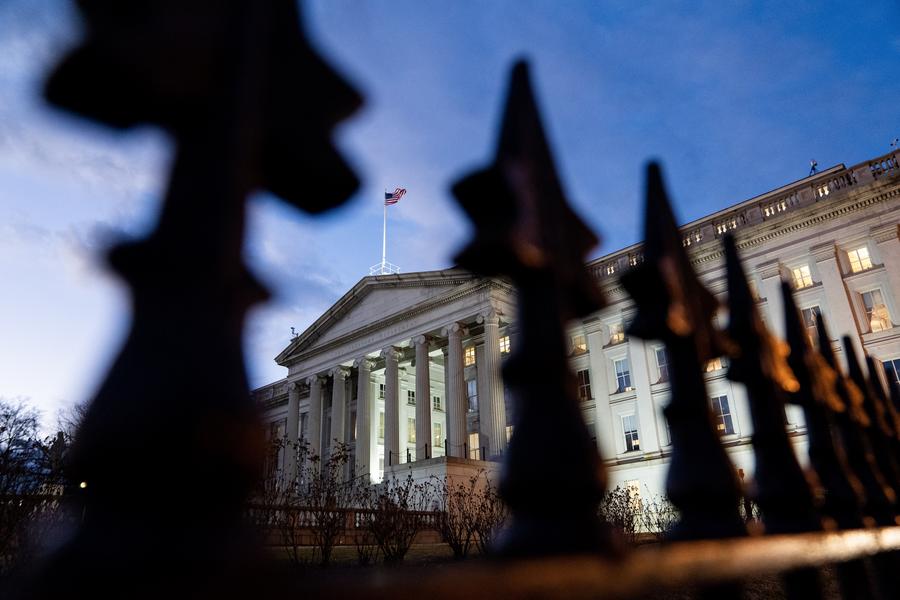Xinhua Headlines: Tariffs can't stop U.S. debt woes, could make them worse
Source: Xinhua
Editor: huaxia
2025-08-23 21:15:17

* In the U.S. Congressional Budget Office's projections, federal debt held by the public will climb to 107 percent of GDP by 2029, exceeding the historical peak it reached immediately after World War II.
* Some policymakers have floated a simple-sounding remedy: make tariffs a central revenue source again. The arithmetic and the economics say otherwise.
* Political dysfunction in Washington is compounding America's already fragile fiscal outlook, analysts warn, raising the risk that partisan fights could worsen the nation's soaring debt burden.
WASHINGTON, Aug. 23 (Xinhua) -- America's gross federal debt has surged past 37 trillion U.S. dollars, a milestone reached earlier this month and five years sooner than pre-pandemic forecasts.
Washington is now adding roughly 1 trillion dollars every five months, swelling a debt snowball that already costs nearly 1 trillion dollars a year in interest -- more than the nation spends on defense or Medicare.
Amid the scramble for solutions, some policymakers have pointed to tariffs as a way to plug the gap. But budget analysts and economists say the math doesn't add up: Tariffs may raise fiscal revenue, yet they do little to slow the accelerating debt and could even make financing it more costly.
WORSENING OUTLOOK
In the Congressional Budget Office's projections, federal debt held by the public will climb to 107 percent of GDP by 2029, exceeding the historical peak it reached immediately after World War II.
Such large and growing debt would slow economic growth, push up interest payments to foreign holders of U.S. debt, and pose significant risks to the fiscal and economic outlook, the office said.
The office also estimates that the total federal budget deficit will remain large by historical standards over the next three decades, averaging 6.3 percent of GDP, more than one and a half times its average over the past 50 years.
The erosion of fiscal space has filtered into America's credit standing. Fitch cut the United States from "AAA" to "AA+" in 2023, S&P Global affirmed its "AA+" rating on Monday, and Moody's downgraded the U.S. sovereign credit rating from "Aaa" to "Aa1" in May, citing concerns about the country's worsening fiscal outlook and its ability to address large and growing deficits. Ratings agencies still credit the economy's resilience and the Federal Reserve's independence, but warn governance risks are rising.
Harvard economist Kenneth Rogoff has warned that debt and financial crises often erupt when a country is already fiscally vulnerable, interest rates are elevated, and political divisions prevent timely action. In his view, the United States now meets all three conditions, leaving only an external shock to trigger a full-blown crisis.
TARIFFS ARE NO FIX
Against that backdrop, some policymakers have floated a simple-sounding remedy: make tariffs a central revenue source again. The arithmetic and the economics say otherwise.
Start with the numbers. Tariff receipts have risen alongside the latest rounds of trade barriers, but they remain a small slice of federal income compared with payroll and individual income taxes.
History and fresh research also show who pays. Studies from the Federal Reserve system find that the bulk of 2018-2019 tariff costs were borne by U.S. importers and consumers, feeding directly into higher domestic prices. Retailers have already warned shoppers to expect higher price tags when new levies take effect.
Inflationary tariffs -- should they become a reality -- also make it harder for the Fed to cut interest rates as U.S. President Donald Trump has repeatedly demanded. They also undermine the very deficit-reduction goals tariffs are supposed to serve by indirectly raising the government's own cost of borrowing.
That has added to Wall Street's worry list: sustained primary deficits, rising interest burdens and eroding fiscal credibility. Tariffs do not fix any of those. Researchers at the University of Pennsylvania estimated that tariffs under the Trump administration could reduce long-run GDP by roughly 6 percent and wages by 5 percent, with middle-income households facing about 22,000 dollars in lifetime loss.

POLITICAL CHAOS DEEPENS DEBT WOES
Political dysfunction in Washington is compounding America's already fragile fiscal outlook, analysts warn, raising the risk that partisan fights could worsen the nation's soaring debt burden.
Rising interest payments for the federal debt are consuming a growing share of the budget, leaving less room for investments or safety-net programs. Economists say unchecked borrowing could push the country toward what billionaire investor Ray Dalio recently described as a "death spiral" that could threaten the stability of the world's largest economy.
Investors are increasingly concerned about the potential for Trump's One Big Beautiful Bill to put pressure on the federal debt burden at a time when there is uncertainty about the outlook for the economy and the appeal of U.S. assets.
Instead of addressing long-term drivers of debt, including entitlement spending and tax reform, Congress remains locked in recurring fights over the debt ceiling. Past standoffs in 2011 and 2023 rattled markets, triggered warnings from credit agencies and added billions in borrowing costs. Even the threat of default, analysts say, can damage America's already questionable reputation as the world's safest borrower.
Without bipartisan agreement on fiscal reforms, political brinkmanship will continue to amplify the country's debt challenges, experts say, threatening higher borrowing costs, slower growth and erosion of the dollar's privileged role in the global economy. ■













Comments